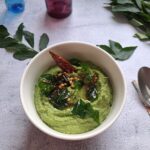Curry leaf chutney

Karuvepillai chutney (curry leaf chutney) is a flavourful and healthy chutney made using fresh curry leaves. It’s packed with nutrients and pairs well with rice, dosa, idli, and other South Indian dishes.
In South India, it’s very common to find a curry leaf plant in almost every household garden. This makes preparing chutneys using fresh curry leaves incredibly easy, as they are readily available. The leaves not only enhance flavour but also add a unique aromatic touch to various dishes. These leaves have a distinct aroma and taste that enhances the flavour of any dish they are added to. Grinding coconut, green chillies, and tamarind balances its spiciness, tanginess, and rich texture. This is not only tasty but also packed with the health benefits of curry leaves. You can enjoy it with dosas, idlis, or even with rice and roti.
Ingredients Used
The ingredients used are simple and easy to find:
Fresh curry leaves: These are the star of the chutney. They give the chutney its unique flavour and fragrance.
Coconut: Freshly grated coconut adds creaminess and richness to the chutney.
Green chillies: These bring heat to the chutney. You can adjust the number of chillies based on your spice preference.
Tamarind: Tamarind adds a tangy flavour that complements the spiciness of the chillies.
Spices: Common spices like mustard seeds, urad dal, and cumin enhance the flavour.
Preparation
Making curry leaf chutney is easy and quick. Follow these steps for a perfect chutney:
Roast the curry leaves: Begin by roasting the curry leaves with other lentils until they are crisp and fragrant. This step helps enhance the flavour of the chutney.
Grind the ingredients: In a blender, add the roasted curry leaves, coconut, green chillies, tamarind, and a pinch of salt. Blend everything until it forms a smooth paste.
Temper the chutney: To give the chutney an extra punch of flavour, heat some oil in a pan and add mustard seeds, urad dal, and curry leaves for tempering. Pour this tempering over the chutney. It`s now ready to serve!
Health Benefits
Curry leaves are known for their numerous health benefits. They are rich in vitamins A, B, C, and E, which support healthy hair, skin, and digestion. The leaves also have antioxidant properties and may help in managing cholesterol and blood sugar levels. Incorporating curry leaf chutney into your meals is an easy and delicious way to enjoy these benefits.
Serving Suggestions
Curry leaf chutney pairs wonderfully with many South Indian dishes. Serve it with idlis or dosas for breakfast, or enjoy it as a side with plain rice and a drizzle of ghee. It also goes well with roti, making it a versatile condiment to add to your meals. It´s a delightful addition to any meal. Its bold flavour, simple ingredients, and quick preparation make it a must-try for anyone who loves South Indian cuisine. Give this recipe a try, and it will soon become a favourite in your home!




Curry leaf chutney
Ingredients
- Fresh curry leaves – 1 handful approximately 15gms, washed
- ½ cup Grated coconut
- 2 tbsp Urad dal
- 1 tbsp Chana dal
- 2 green chillies
- 10 shallots
- Tamarind – a small piece or 1/2 tsp tamarind paste
- 2 Garlic cloves
- 1- inch size ginger
- 2 tbsp Oil
- Salt to taste
- Water as needed for grinding
For tempering:
- 1 tbsp Oil
- ½ tsp Mustard seeds
- ½ tsp urad dal
- 1 dry red chilli
- A pinch of Asafoetida/hing
- A few curry leaves
Instructions
- Heat 1 tbsp of oil in a pan. Add urad dal and chana dal. Fry until the dals turn golden brown.
- Add the garlic, ginger, green chillies, shallots, tamarind, salt and saute.
- Add the curry leaves and roast them until they become crisp and aromatic.
- Add the grated coconut and combine well.
- Turn off the flame and let it cool.
- Add this into a mixer with a little water and grind to a smooth paste. Adjust the consistency by adding more water if needed.
Tempering:
- In a small pan, heat oil and add mustard seeds. Once they splutter, add dry red chilli, asafoetida/hing and curry leaves. Pour this tempering over the chutney.
- Serve the karuvepillai chutney with dosa, idli, or rice! It’s a nutritious, flavourful chutney that elevates any meal.
Frequently Asked Questions
Curry leaf chutney has a unique earthy, slightly nutty flavour with the herbal aroma of curry leaves. The taste can vary depending on the ingredients like coconut, tamarind, or spices used in the recipe.
Yes, curry leaves are rich in antioxidants, vitamins, and minerals. They are known to aid digestion, improve hair health, and have anti-inflammatory properties.
You can store them in an airtight container in the refrigerator for up to 2-3 days. For longer storage, you can freeze it in portions for up to a month.
Curry leaf chutney pairs well with idli, dosa, rice, chapathi, or as a spread for sandwiches and wraps. It can also be a side dish for snacks like pakoras or samosas.
Fresh curry leaves are preferred for their aroma and flavour, but you can use dried curry leaves if fresh ones are unavailable. The flavour will be less intense, so you might need to increase the quantity slightly.
To reduce bitterness, roast the curry leaves slightly before grinding. Adding tamarind, lemon juice, or a small amount of jaggery can also balance the flavours.
Yes, tamarind can be omitted, but it adds a tangy taste to the chutney. You can substitute it with lemon juice or skip it entirely for a different flavour profile.
Coconut oil is traditionally used and adds an authentic flavour. However, you can also use vegetable oil or sesame oil based on your preference.
Absolutely! Increase the amount of green or red chillies to suit your spice tolerance.
If your chutney thickens after refrigeration, add a little warm water and mix well to achieve the desired consistency.
Share Your Creations and Connect with Me on Social Media!
Have you tried this recipe? Don’t forget to tag me with your pictures on Instagram – I love to see your creations! 💕 Also, be sure to comment and rate below! Follow me on social media:
2 thoughts on “Curry leaf chutney”